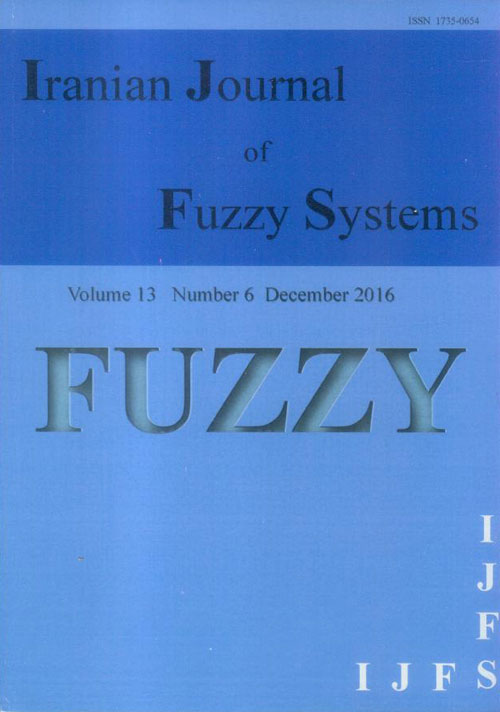فهرست مطالب

Iranian journal of fuzzy systems
Volume:13 Issue: 6, nov - Dec 2016
- 170 صفحه،
- تاریخ انتشار: 1395/10/20
- تعداد عناوین: 8
-
-
صفحه 135
-
صفحه 153
-
Page 1In this study, an image backlight compensation method using adaptive luminance modification is proposed for efficiently obtaining clear images.
The proposed method combines the fuzzy C-means clustering method, a recurrent functional neural fuzzy network (RFNFN), and a modified differential evolution.
The proposed RFNFN is based on the two backlight factors that can accurately detect the compensation degree. According to the backlight level, the compensation curve function of a backlight image can be adaptively adjusted. In our experiments, six backlight images are used to verify the performance of proposed method.
Experimental results demonstrate that the proposed method performs well in backlight problems.Keywords: Neural fuzzy network, Recurrent network, Differential evolution, Fuzzy c, means, Backlight compensation, Contrast enhancement -
Page 21Fuzzy measures are suitable in analyzing human subjective evaluation processes. Several different strategies have been proposed for distance of fuzzy numbers. The distances introduced for fuzzy numbers can be categorized in two groups:\\
1. The crisp distances which explain crisp values for the distance between two fuzzy numbers.\\
2. The fuzzy distance which introduce a fuzzy distance for normal fuzzy numbers. It was introduced by Voxman \cite{33} for the first time through using $\alpha$-cut.\\
However, both mentioned concepts can lead to unsatisfactory results from the applications point of view, but there is no method, which gives a satisfactory result to all situations. In this paper, a new attitude coupled with fuzzy thinking to the fuzzy distance function on the set of fuzzy numbers is proposed. In this new fuzzy distance, we considered both mentioned attitudes, then we introduced new fuzzy distance based on a combination (hybrid) of those two. Some properties of the proposed fuzzy distance have been discussed. Finally, several examples have been provided to explain the application of the proposed method and compare this methods with others.Keywords: Pseudo, geometric fuzzy numbers, Transmission average (TA), Ranking fuzzy numbers, Fuzzy absolute of fuzzy number, Fuzzy distance function (fuzzy metric) -
Page 41Organizations need to evaluate project proposals and select the ones that are the most effective in reaching the strategic goals by considering sustainability issue. In order to enhance the effectiveness and the efficiency of project oriented organizations, in this paper a new multi-objective decision making (MODM) approach of sustainable project portfolio selection is proposed which applies interval-valued fuzzy sets (IVFSs) to consider uncertainty. In the proposed approach, in addition to sustainability criteria, other practical criteria including non-financial benefits, strategic alignment, organizational readiness and project risk are incorporated. The presented approach consists of three main parts: In the first part, a novel composite risk return index based on the IVFSs is introduced and used to form the first model to evaluate the financial return and risk of the proposed projects. In the second part, a new risk reduction compromise ratio model is introduced to evaluate projects versus non-financial criteria. Finally, an MODM model is presented to form the overall objective function of the approach. In order to make the approach more suitable for real-world situations, a group of applicable constraints is included in the proposed approach. The constraints are based on limitations and issues existing in practical project portfolio management. Due to importance of uncertainty and risk in project portfolio selection, they are addressed separately in three parts of the approach. In the first part, a novel downside risk measure is introduced and applied to assess financial risk of projects. In the second part of the approach, not only project risk is accounted for as a criterion, but also a new method is introduced to control and limit the risk of uncertainty and to use the advantages of IVFSs. Finally, the proposed IVF-MODM approach is applied to select the optimal sustainable project portfolio in real case study of a holding company in a developing country. The results show that the approach can successfully address highly uncertain environments. Moreover, risk has been fully explored from different perspectives. Eventually, the approach provided the decision makers with more flexibility in focusing on financial and non-financial criteria in the selection process.Keywords: Sustainable project portfolio selection, Multi, objective optimization, Interval, valued fuzzy sets (IVFSs), Risks, uncertainties, Holding companies
-
Page 69In this paper, a fuzzy numerical procedure for solving fuzzy linear Volterra integro-differential equations of the second kind under strong generalized differentiability is designed. Unlike the existing numerical methods, we do not replace the original fuzzy equation by a $2\times 2$ system of crisp equations, that is the main difference between our method and other numerical methods. Error analysis and numerical examples are given to show the convergency and efficiency of the proposed method, respectively.Keywords: Fuzzy number, Fuzzy linear Volterra integro, differential equation, Generalized differentiability, Fuzzy trapezoidal rule
-
Page 89It is firstly proved that the multi-input-single-output (MISO) fuzzy systems based on interval-valued $R$- and $S$-implications can approximate any continuous function defined on a compact set to arbitrary accuracy. A formula to compute the lower upper bounds on the number of interval-valued fuzzy sets needed to achieve a pre-specified approximation accuracy for an arbitrary multivariate continuous function is then presented. In addition, a method to design the interval-valued fuzzy systems based on $R$- and $S$-implications in order to approximate a given continuous function with a required approximation accuracy is represented. Finally, two numerical examples are provided to illustrate the proposed procedure.Keywords: Interval, valued fuzzy sets, Interval, valued fuzzy implications, Interval, valued fuzzy systems, Universal approximator, Sufficient condition
-
Page 153

